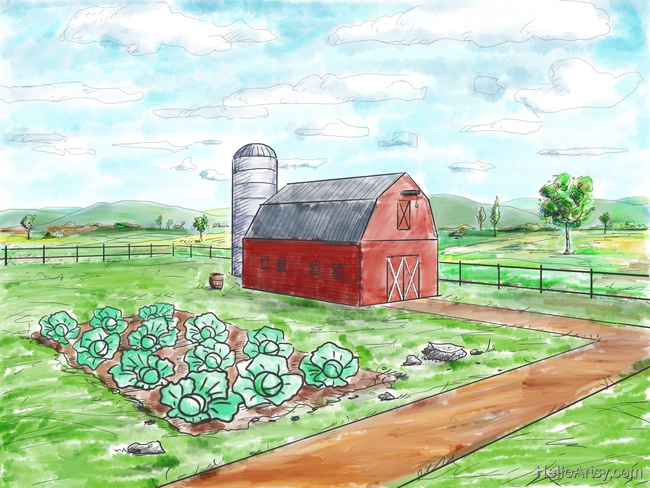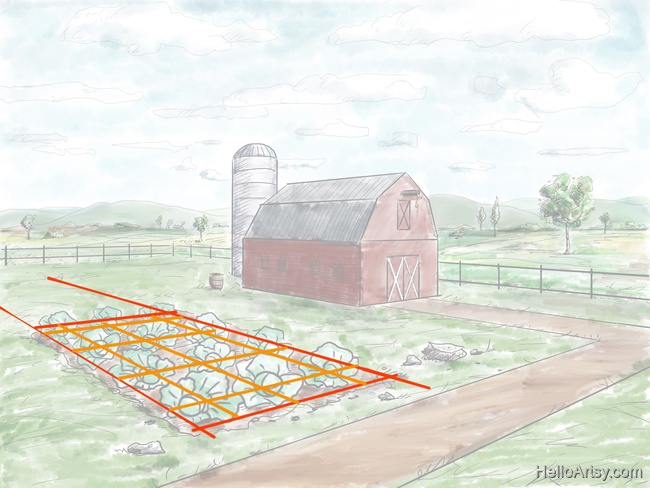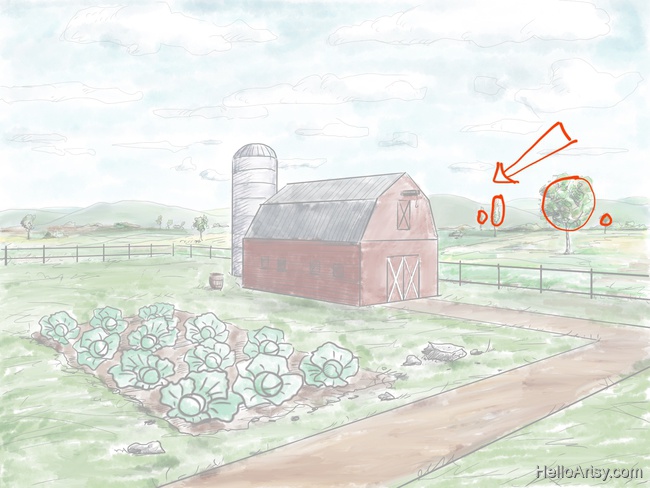When thinking about drawing in perspective, we typically think about architecture. Perspective drawing skills however, also show up in more natural settings such. Let’s go over a few strategies for discovering perspective in landscape drawings.

Drawings via HelloArtsy.com
Drawing natural elements around a structure
When you’re drawing a complex structure, you don’t need to worry about the perspective of the natural elements around it, right? Think again! Any object that exists in space should adhere to some simple perspective rules.
Let’s examine some bushes along a walkway:

It usually makes sense to draw the closest item first. In this case I created the leftmost bush first. You can then use a series of temporary perspective lines to calculate the heights of the other bushes; the ones leading farther away from us.

Now imagine the bushes being something else — like a row of trees or flower pots. You can apply the same technique: Draw the closest one first, then use temporary perspective lines to place the rest. There are even ways of determining the proper spacing between each bush or tree.
If you’re relatively new to perspective drawing you can place each bush by eye. Just make sure that each bush gets smaller and closer to the previous one as they recede away into the distance.
Using two-point perspective for landscape drawings
Most of the time, landscape drawings incorporate the viewpoint of looking out, deep into the distance. This point of view makes two-point-perspective a good method for incorporating into your landscape drawing.
So how can two-point-perspective be incorporated into a landscape if everything is curved and very organic in shape? You have to learn to see the geometric structure of the environment.
Let’s draw out a few examples with the drawing you saw at the top of this post.
The drawing is a fairly simple farm scene. It’s most obvious that perspective has been used to complete the barn. But let’s investigate some of the other landscape elements a bit further to see how perspective comes into play.
1. Gardens
First up is the garden field in front of the barn, closest to us. Looks like this farmer is growing some cabbage!
Even though the rows of vegetables are quite organic in shape, they do adhere to parts of a perspective grid! Each vegetable forms lines that connect back to the vanishing points.

The illustration above highlights the grid-like nature of the cabbage field. Notice how the centers of each cabbage plant line up with each intersection of the perspective grid! Just remember to provide some variety to your drawing. Not every cabbage is exactly the same, of course.
Clever, huh?
Knowing how to see perspective where it is not so obvious allows you to create realistic renderings with ease. When new to drawing, setting up this perspective grid lightly in pencil first is a great idea. As you gain experience, this process will become more intuitive and you’ll be able to draw with greater accuracy and realism — without drawing an actual grid.
You want all your perspective elements to be worked out lightly first to establish the overall structure. You can then draw all of the organic shapes on top of the perspective structure.
2. Trees and clouds
Not everything you draw will easily align to a perspective grid. A couple of random trees that do not follow a line or grid pattern comes to mind. You probably don’t want to grid out your clouds either.
The overarching rule that governs all linear perspective drawing is that elements need to be drawn smaller as they recede from vision (move farther away).
It’s the vanishing points that enforce this rule, but being aware we can simply make things smaller without everything being directly connected to vanishing points.

Knowing this, simply draw trees and clouds smaller as they get farther away. Of course, every tree is not the same height, so you’ll have to factor that into your drawing as well.
At the same time, each cloud should not be the same shape, so any seasoned artist will allow for a great variety within the drawing.

Notice how the trees get smaller moving up towards the horizon while the clouds get smaller moving down towards the horizon.

Share tips, start a discussion or ask one of our experts or other students a question.
No Responses to “Beyond Buildings: The Key to Using Perspective for Landscapes”